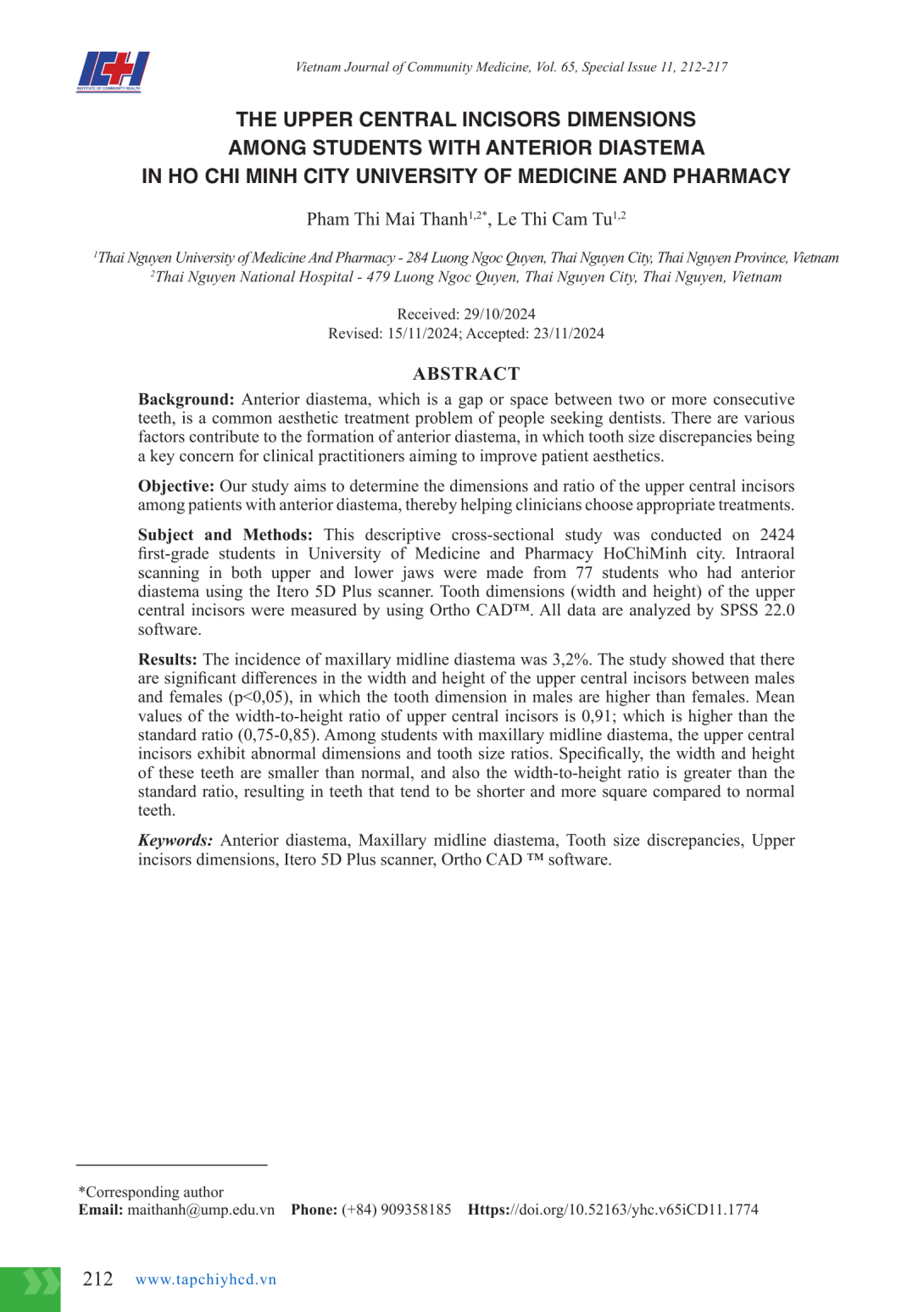
Khe thưa vùng răng cửa là một nhu cầu điều trị thẩm mỹ thường gặp, đồng thời cũng là một thử thách đối với các bác sĩ nha khoa. Có nhiều nguyên nhân góp phần tạo nên khe thưa răng cửa, trong đó bất hài hòa về kích thước răng là yếu tố mà các bác sĩ lâm sàng quan tâm để cải thiện thẩm mỹ cho bệnh nhân. Mục tiêu: Nghiên cứu của chúng tôi nhằm xác định kích thước và tỷ lệ kích thước răng cửa giữa trên ở nhóm đối tượng khe thưa răng cửa, qua đó giúp nhà lâm sàng có thể lựa chọn điều trị phù hợp. Đối tượng và phương pháp nghiên cứu: Nghiên cứu cắt ngang mô tả trên 2424 sinh viên năm thứ nhất Đại học Y Dược TP.HCM. Qua khám sức khỏe tổng quát, ghi nhận có 77 sinh viên có khe thưa răng cửa. Sử dụng máy scan trong miệng Itero 5D Plus để scan dấu răng hai hàm, và phần mềm Ortho CAD™ để đo đạc kích thước chiều rộng, chiều cao thân răng cửa giữa hàm trên. Số liệu được nhập và xử lý bằng phần mềm SPSS 22.0. Kết quả: Tỷ lệ khe thưa răng cửa là 3,2% (77/2424 sinh viên). Nghiên cứu cho thấy có sự khác biệt có ý nghĩa chiều rộng và chiều cao thân răng cửa giữa trên giữa nam và nữ (p<0,05); kích thước thân răng cả chiều rộng và chiều cao đều nhỏ hơn kích thước răng bình thường, trong đó tỷ lệ chiều rộng/chiều cao là 0,91; lớn hơn so với tỷ lệ chuẩn (0,75-0,85). Kết luận: Ở sinh viên có khe thưa, răng cửa giữa hàm trên có sự bất thường về kích thước và tỷ lệ, cụ thể là chiều rộng và chiều cao thân răng đều nhỏ hơn răng bình thường, tỷ lệ rộng/cao lớn hơn tỷ lệ chuẩn, do đó thân răng có khuynh hướng ngắn và vuông hơn răng bình thường.
Anterior diastema, which is a gap or space between two or more consecutive teeth, is a common aesthetic treatment problem of people seeking dentists. There are various factors contribute to the formation of anterior diastema, in which tooth size discrepancies being a key concern for clinical practitioners aiming to improve patient aesthetics. Objective: Our study aims to determine the dimensions and ratio of the upper central incisors among patients with anterior diastema, thereby helping clinicians choose appropriate treatments. Subject and Methods: This descriptive cross-sectional study was conducted on 2424 first-grade students in University of Medicine and Pharmacy HoChiMinh city. Intraoral scanning in both upper and lower jaws were made from 77 students who had anterior diastema using the Itero 5D Plus scanner. Tooth dimensions (width and height) of the upper central incisors were measured by using Ortho CAD™. All data are analyzed by SPSS 22.0 software. Results: The incidence of maxillary midline diastema was 3,2%. The study showed that there are significant differences in the width and height of the upper central incisors between males and females (p<0,05), in which the tooth dimension in males are higher than females. Mean values of the width-to-height ratio of upper central incisors is 0,91; which is higher than the standard ratio (0,75-0,85). Among students with maxillary midline diastema, the upper central incisors exhibit abnormal dimensions and tooth size ratios. Specifically, the width and height of these teeth are smaller than normal, and also the width-to-height ratio is greater than the standard ratio, resulting in teeth that tend to be shorter and more square compared to normal teeth.
- Đăng nhập để gửi ý kiến
